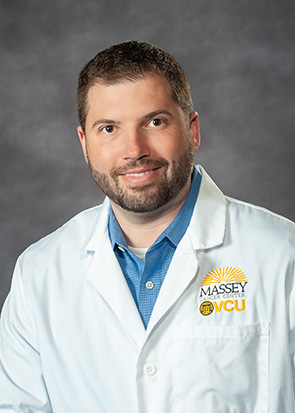Progress against skin cancers
Exciting advancements have been made in the treatment of skin cancers, especially melanoma. Massey doctors are on the forefront of these developments, and many new treatments were made available as clinical trials prior to becoming approved for commercial use by the FDA. Thanks to new precision drugs and immunotherapies, long-term survival is now possible for patients with advanced skin cancers.
Massey offers the full range of treatment options for skin cancers led by the region’s largest and most specialized team of experts. We partner with VCU Health Dermatology for rapid, accurate diagnosis and evaluation, seamless coordination of care and long-term surveillance and follow-up for high-risk patients with early-stage cancers. Through genetic counseling we can help determine who is at the greatest risk for cancer recurrence and partner with those patient’s referring providers for active surveillance and preventative treatment.
A dedicated nurse navigator guides each patient through their care, helping to coordinate appointments and ensure smooth transitions. We also have a variety of resources available, including social workers, rehabilitation experts, occupational therapists and other integrative health and supportive care resources for patients and their caregivers.
Treatments for skin cancers may include:
Surgery
There are several different surgical procedures that may be used to treat various forms of skin cancer. Some may be performed by a dermatologist with advanced training and some may be performed by a surgical oncologist, depending on the cancer type and stage of the disease. Types of surgeries include:
- Simple excision: In this procedure, the tumor is removed from the skin along with some additional tissue to ensure complete removal.
- Mohs micrographic surgery: A dermatologist with specialized training removes the tumor from the skin in thin layers. Throughout the procedure, the tissue is examined under a microscope to check for cancer cells. While sparing as much healthy tissue as possible, layers continue to be removed until there is no evidence of cancer.
- Curettage and electrodesiccation: This procedure, also known as electrosurgery, uses a sharp, spoon-shaped tool called a curette to remove the tumor from the skin. An electrode then sends an electric current to the area to stop the bleeding and destroy remaining cancer cells. The process may be repeated to remove all of the cancer.
- Cryosurgery: Cryosurgery, or cryotherapy, uses liquid nitrogen or another solution to freeze and destroy abnormal tissue.
- Dermabrasion: This removes the top layer of skin using a rotating wheel or abrasive particles to rub away tissue.
- Laser surgery: This uses a laser beam to make bloodless cuts in tissue or to remove a surface lesion.
Targeted therapy
Targeted therapies use drugs or other substances to attack specific weaknesses in the cancer cell, usually a genetic mutation or specific molecules involved with cancer growth. These therapies typically cause less harm to healthy cells than chemotherapy or radiation therapy.
Several new targeted therapies have been approved for melanoma and other skin cancers in recent years, and scientists are constantly searching for new molecular targets that may eventually lead to clinical trials testing promising new drugs and other treatments.
Immunotherapy
Immunotherapy refers to a treatment that helps the immune system identify and attack cancer cells. There are a few different types of immunotherapies:
- Checkpoint inhibitors have been revolutionary in the treatment of patients with advanced skin cancers. It is difficult for the immune system to distinguish cancer cells from normal cells, so these drugs target molecules on immune cells that enable them to recognize and attack cancer cells. PD-1 inhibitors, such as Keytruda or Opdivo, for example, block the expression of a protein known as PD-1, which acts as a switch or checkpoint that helps keep T-cells from attacking other cells. These drugs “take the brakes off” the immune system and allow it to attack cancer cells.
- Cellular therapies are a different type of immunotherapy that modifies a patient’s own immune cells in a laboratory to attack cancer. An example of this type of therapy uses immune cells known as tumor infiltrating lymphocytes (TIL), which are immune cells that have been able to penetrate the tumor. These cells are collected from the tumor when it is removed, millions of copies are grown in the lab and then are injected back into the patient to help prevent recurrence or attack other tumors that aren’t surgically treatable.
- Cytokines, such as interferon-alfa and interleukin-2 (IL-2), are proteins that give an overall boost to the immune system. These drugs can help shrink tumors and are sometimes used in combination with other treatments. .
- Viral therapies, or oncolytic virus therapies, use viruses that have been modified to primarily infect and kill cancer cells and to alert the immune system to attack the cancer.
- Imiquimod cream (Zyclara) is a topical cream that stimulates a local immune response against cancer cells. This therapy is only used for very early cancers.
Chemotherapy
In most cases, chemotherapy works by targeting rapidly dividing cells and interfering with their ability to grow or reproduce. Different groups of drugs work in different ways to fight cancer cells. Chemotherapy may be used alone for some types of cancer or in combination with other treatments such as radiation or surgery. Often, a combination of chemotherapy drugs may be used, and certain chemotherapy drugs may be given in a specific order depending on the type of cancer it is being used to treat.
Radiation
Radiation therapy uses highly focused doses of radiation to kill cancer cells. Massey’s Radiation Oncology Department is home to nationally renowned radiation oncologists, medical physicists and dosimetrists, as well as the latest technology and practices, all coming together to offer the best available care. Massey has even pioneered new radiation therapy techniques and devices that have become standard of care nationally.
There are two types of radiation therapy:
External beam radiation therapy uses state-of-the-art linear accelerators to deliver a highly focused beam of radiation to the tumor. Massey utilizes the latest in MRI imaging technologies to destroy as much cancer as possible while sparing healthy tissue.
Internal radiation therapy, also known as brachytherapy, uses radioactive substances inserted into needles, wires or catheters to kill cancer cells from directly inside the tumor or nearby the tumor. This form of radiation therapy can offer advantages such as higher dose rates and sometimes shortened treatment plans.


















